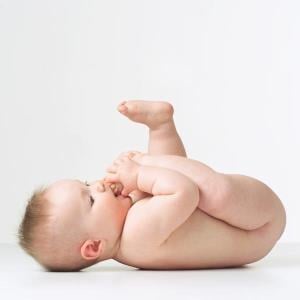
Colic
Colic is generally defined as being the distressing state in which your baby cries non-stop for more than three hours a day, at least three days a week. He will tend to cry at the same time of day or night – usually between 6pm and 10pm – and frequently clench his fists and draw his knees up towards his tummy.
There are a few theories about what causes colic. Most experts believe that it could be a combination of a few things, including an allergy to something in the milk, an immature intestinal tract, a low threshold for stimulation or a tense mother/caregiver. Around 10 to 20% of all babies tend to suffer from colic.
The good news is that it generally stops completely by the age of 5 to 6 months, having begun typically within your baby’s early weeks of life peaking at about 6 weeks.
Dr Archie Taylor-Smith of Morningside Mediclinic says that breastfed babies are just as prone to colic as bottle-fed babies. He says it’s possible that a breastfed baby’s immature immune system hasn’t yet adapted to the food his mother might be eating (eg, caffeine, dairy products and nuts) which he absorbs from her breastmilk.
Try this
First eliminate any obvious reasons for your baby’s crying, such as a wet nappy, slight temperature or nappy rash. Then you could:
- Run a warm bath and rub his back and tummy with a lather of mild soap, or hum or sing to your baby to calm him down
- Lie him on his tummy and massage his back with baby oil or lotion
- Apply a soothing warmth to his tummy, such as a warm receiving blanket, a hot water bottle, or your knee
- Lie him on his back and move his legs in a gentle cycling motion, to help him pass wind
- Give him a dummy to suck on, or see if he wants to nurse or have a bottle (especially if he’s been crying for over half an hour)
- See if he wants to be held, rocked, walked, swung or driven in the car to be soothed by its vibrations
- Try a “white noise” source in the background, such as a soothing CD or even the vacuum cleaner
- Note that some paediatricians prefer you to stay away from gripe water, as they believe that the sodium in it is too taxing on your baby’s immature kidneys. But some moms swear by it. Try Telament drops (alcohol-free)
- Give your baby an antispasmodic syrup to relieve cramping. Try Telament colic solution, Bennets colic mixture, or Buscopan syrup
- Book an appointment with a chiropractor who specialises in treating babies with colic. The theory is that by relaxing joints in the spine that may be stiff and irritated, an extra stimulus that may be causing your baby to cry is removed.
Tips
- Your baby will continue to cry whether you are there or not. Ask friends or family to give you some time away from your crying baby as often as you can
- If you’re breastfeeding, watch your diet and avoid caffeine. Don’t smoke
- Remember the saying: “Everything works at first – for a little while”
- Be there for your baby while he cries, but help yourself and your partner to stay sane
- Remember that it too will pass one day.
Reflux
Reflux occurs when the stomach’s contents come back up into the oesophagus or the mouth. The medical term for reflux is gastro-oesophageal reflux disease. It occurs when the sphincter action of your baby’s diaphragm isn’t fully developed and his stomach contents return up his oesophagus.
Reflux can occur during the first year of your baby’s life, until the sphincter action has had time to mature. About 50% of babies will get some reflux but in a few is it a real problem. By the age of 10 months the number declines to about one in 20 babies.
Your baby may regurgitate a little milk after a feed or have hiccups. He may also occasionally cough a little after regurgitating the milk if a little has gone "down the wrong way". This is normal and as long as he is otherwise well, you don’t need to worry. Both formula-fed and breastfed babies may be affected.
Speak to your health visitor or doctor if:
- If your baby’s reflux is happening more than 5 times a day on a regular basis
- If your baby cries excessively after feeds
- If he regularly vomits
- If his coughing becomes a regular occurrence.
Try this
- Hold your baby upright for at least 20 minutes after a feed
- Try to give him smaller feeds, more frequently
- In more severe cases, you could try an antacid or a feed thickener. These products are available on prescription. Use them on the advice of your baby clinic or doctor and stop them every once in a while to check whether things have improved.
Return to your GP or paediatrician if:
- Your baby’s condition does not improve with simple treatments
- There is blood in his vomit
- You suspect your baby might have become anaemic
- Your baby has persistent coughing or frequent chest infections
- Your baby fails to gain weight or begins to refuse food
- Your baby has difficulty swallowing.
Remember that reflux generally improves as your baby grows, and most babies will suffer some of the minor symptoms of reflux without complications.
Nappy rash
When your baby has nappy rash, some of the skin covered by the nappy – generally the genital area, the folds of the thighs and the buttocks - will appear red and inflamed. The affected areas can be either dry or moist and can sometimes look pimply. If the basic nappy rash isn’t treated, it can grow into a fungal infection, such as a yeast or bacterial infection.
Yeast infections are more common in babies taking antibiotics and typically begin as tiny red spots that multiply and mass into a solid, red blotch. Bacterial infections, which can be accompanied by fever, usually cause oozing yellow patches or pus-filled pimples.
The main cause of nappy rash is wetness. Newborns urinate often and have frequent, loose bowel movements. Even the most absorbent nappy leaves some moisture on your baby’s delicate new skin. If your baby is left in a dirty nappy for too long he is likely to develop nappy rash, but if he has a very sensitive skin, he’ll still be more prone to nappy rash even if you change his nappy often. Older babies who are sick and taking antibiotics may get diarrhoea as a side effect, which can cause nappy rash.
Try this
- Keep your baby clean and dry by changing his nappy frequently and drying his bottom thoroughly before putting a new nappy on
- Try bathing his bottom in cool (black) rooibos tea
- Leave him with his nappy off in a warm, protected place for a short time every day. The air on his skin will speed up the healing process
- Try switching your disposable nappy to a brand that is fragrance or additive-free. If you use cloth nappies, the same goes for your detergent. This will probably clear up the problem if the nappy rash is allergy-based
- Use nappy liners with fabric nappies
- Use a bum cream whenever you change your baby’s nappy. The Bennets and Fissan crème (white tub) products are good for daily use to prevent nappy rash, but when the nappy rash has already occurred you need something stronger. Try Fissan’s again, but the pink tub this time
- If your baby’s nappy rash is due to a very loose stool, try applying Bepanthen or Antipeol ointments
- If your baby is taking antibiotics, ask your doctor for probiotics to counteract the possibility of diarrhoea caused by the medication
- Many moms find making a paste of water and Maizena and applying it to their baby’s bottom helps hugely
- A normal nappy rash should clear up after three or four days of at-home treatment. If your baby’s rash seems to be thrush-based, try an anti-yeast cream, such as Canesten, for a few days.
Tips
- Many pharmacists make up nappy rash creams using their own mix of preferred ingredients. Ask your pharmacist if you don’t see such a cream straight away – it might be at the back of the dispensary
- Don’t use talcum powder when you change your baby – it can get into his lungs
- Avoid perfumed products, harsh soaps and baby wipes containing alcohol
- When your baby starts solid food, introduce only one new food at a time, and wait a few days between introductions. That way you can tell if the rash is due to a food allergy.
Cradle cap
Cradle cap looks like a very bad case of dandruff and appears as scaly, sometimes reddish patches on your baby’s scalp, or on his face and nappy area. It can occur in newborns and older babies, is very common and quite harmless.
Try this
- Rub a mild baby oil or aqueous cream into your baby’s scalp and then remove the flakes with a sponge, soft baby brush or comb. Do this a few times over a few days
- Wash your baby’s hair with a special baby shampoo, such as Elizabeth Anne’s, Infaderm or Johnson & Johnson’s to treat and prevent cradle cap
- Don’t wash your baby’s hair on a daily basis, though, especially while he’s very young. One to three times a week is enough to keep his hair clean.




 Publications
Publications
 Partners
Partners














